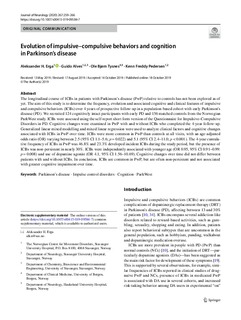| dc.contributor.author | Erga, Aleksander Hagen | |
| dc.contributor.author | Alves, Guido Werner | |
| dc.contributor.author | Tysnes, Ole-Bjørn | |
| dc.contributor.author | Pedersen, Kenn Freddy | |
| dc.date.accessioned | 2020-02-21T09:47:59Z | |
| dc.date.available | 2020-02-21T09:47:59Z | |
| dc.date.created | 2019-11-07T13:54:11Z | |
| dc.date.issued | 2019-10 | |
| dc.identifier.citation | Erga, A.H., Alves, G., Tysnes, O.B. et al. (2019) Evolution of impulsive–compulsive behaviors and cognition in Parkinson’s disease. Journal of Neurology, 267, pp 259–266 | nb_NO |
| dc.identifier.issn | 0340-5354 | |
| dc.identifier.uri | http://hdl.handle.net/11250/2643171 | |
| dc.description.abstract | The longitudinal course of ICBs in patients with Parkinson’s disease (PwP) relative to controls has not been explored as of yet. The aim of this study is to determine the frequency, evolution and associated cognitive and clinical features of impulsive and compulsive behaviors (ICBs) over 4 years of prospective follow-up in a population-based cohort with early Parkinson’s disease (PD). We recruited 124 cognitively intact participants with early PD and 156 matched controls from the Norwegian ParkWest study. ICBs were assessed using the self-report short form version of the Questionnaire for Impulsive–Compulsive Disorders in PD. Cognitive changes were examined in PwP with and without ICBs who completed the 4-year follow-up. Generalized linear mixed modelling and mixed linear regression were used to analyze clinical factors and cognitive changes associated with ICBs in PwP over time. ICBs were more common in PwP than controls at all visits, with an age-adjusted odds ratio (OR) varying between 2.5 (95% CI 1.1–5.6; p = 0.022) and 5.1 (95% CI 2.4–11.0; p < 0.001). The 4-year cumulative frequency of ICBs in PwP was 46.8% and 23.3% developed incident ICBs during the study period, but the presence of ICBs was non-persistent in nearly 30%. ICBs were independently associated with younger age (OR 0.95, 95% CI 0.91–0.99: p = 0.008) and use of dopamine agonist (OR 4.1, 95% CI 1.56–10.69). Cognitive changes over time did not differ between patients with and without ICBs. In conclusion, ICBs are common in PwP, but are often non-persistent and not associated with greater cognitive impairment over time. | nb_NO |
| dc.language.iso | eng | nb_NO |
| dc.publisher | © 2019 Springer Nature Switzerland AG. | nb_NO |
| dc.rights | Navngivelse 4.0 Internasjonal | * |
| dc.rights.uri | http://creativecommons.org/licenses/by/4.0/deed.no | * |
| dc.subject | nevrologi | nb_NO |
| dc.subject | Parkinson’s disease | nb_NO |
| dc.subject | Parkinson | nb_NO |
| dc.subject | ParkWest | nb_NO |
| dc.title | Evolution of impulsive–compulsive behaviors and cognition in Parkinson’s disease | nb_NO |
| dc.type | Journal article | nb_NO |
| dc.type | Peer reviewed | nb_NO |
| dc.description.version | publishedVersion | nb_NO |
| dc.rights.holder | © The Author(s) 2019 | nb_NO |
| dc.subject.nsi | VDP::Medical disciplines: 700::Clinical medical disciplines: 750::Neurology: 752 | nb_NO |
| dc.source.pagenumber | 8 | nb_NO |
| dc.source.journal | Journal of Neurology | nb_NO |
| dc.identifier.doi | 10.1007/s00415-019-09584-7 | |
| dc.identifier.cristin | 1744967 | |
| cristin.unitcode | 217,8,10,0 | |
| cristin.unitname | Institutt for kjemi, biovitenskap og miljøteknologi | |
| cristin.ispublished | true | |
| cristin.fulltext | original | |
| cristin.qualitycode | 2 | |

